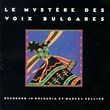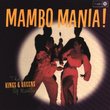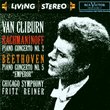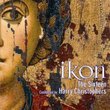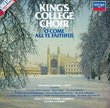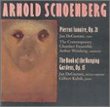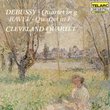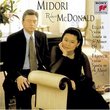| All Artists: Hovhaness, Robertson, Royal Scottish National Orchestra, Calderon Title: Hovhaness: Guitar Concerto No. 2 Members Wishing: 2 Total Copies: 0 Label: Naxos American Classics Original Release Date: 1/1/2008 Re-Release Date: 6/24/2008 Genre: Classical Styles: Forms & Genres, Concertos, Historical Periods, Modern, 20th, & 21st Century, Instruments, Strings, Symphonies Number of Discs: 1 SwapaCD Credits: 1 UPC: 636943933626 |
Search - Hovhaness, Robertson, Royal Scottish National Orchestra :: Hovhaness: Guitar Concerto No. 2
 | Hovhaness, Robertson, Royal Scottish National Orchestra Hovhaness: Guitar Concerto No. 2 Genre: Classical Alan Hovhaness was one of the most prolific composers of the twentieth century. He stood alone among composers who were otherwise writing according to the flow of modern thinking, opposed to melody and emotion, and dismiss... more » |
CD DetailsSynopsis
Album Description Alan Hovhaness was one of the most prolific composers of the twentieth century. He stood alone among composers who were otherwise writing according to the flow of modern thinking, opposed to melody and emotion, and dismissing classical form and contrapuntal writing. Fanfare for the New Atlantis is a symphonic celebration of the rebirth of the legendary island of Atlantis. The Guitar Concerto No. 2 is full of lively dance-like music and rapidly changing rhythmic patterns. Symphony No. 63 `Loon Lake' is full of nostalgia for the New Hampshire countryside of Hovhaness's youth. It was commissioned by the New Hampshire Music Festival in conjunction with the Loon Preservation Society, who specifically requested the sound of the loon cry to be in the symphony. All three works are world première recordings. Similarly Requested CDs
|
CD ReviewsExploring Hovhaness on Naxos Robin Friedman | Washington, D.C. United States | 06/29/2008 (5 out of 5 stars) "This is the fourth CD in Naxos's "American Classics" series devoted to the music of Alan Hovhaness (1911 --2000). The earlier CD's feature three Hovhaness wind symphonies, and two orchestral symphonies: Symphony no 60, "To the Appalachian Mountains" and Symphony no. 22, the "City of Light.". In addition, the Naxos disks offer an early cello concerto and Hovhaness' first guitar concerto together with various shorter works. This most recent Naxos CD includes three world-premier recordings of the "Fanfare for the New Atlantis", op.281, the Concerto no. 2 for Guitar and Strings, op. 394, and the late Symphony no. 63, 'Loon Lake" opus 411, written when Hovhaness was 76. The Royal Scottish National Orchestra is conducted by Stewart Robinson with Javier Calderon as the guitar soloist in the concerto. Hovhaness's widow Himako Fujihara Hovhaness, who is consulting with Naxos on the ongoing series, wrote the liner notes. Hovhaness' music remains controversial but has been gaining recognition since the composer's death. The music features long, sinuous, slow and majestic orchestral themes, brass chorales, imaginative orchestration, and substantial use of counterpoint. The immediate accessibility of Hovhaness' music should not, I believe, be confused with shallowness. It has a broad visionary dimension, heavily inluenced by eastern thought. Much of Hovhaness' music draws on themes pertaining to nature, and some of it has a distinctively exotic cast. Some listeners find a certain repetitiveness in Hovhaness' music. I would prefer to call it a recognizable style. Still his work is best approached by listening to him at different times, spaced between other music. The Naxos recordings, issued at fairly lengthy intervals, offer an excellent opportunity to visit and revisit Hovhaness. I love his music and find it seldom disappoints. The Fanfare for the New Atlantis opens with a distant solo trumpet over a long held note in the low strings. The music soon turns into a solemn brass chorale which ultimately works itself into a majestic and triumphal close. This is a short, visionary work which has been too infrequently heard. An earlier Naxos CD featured Hovhaness first guitar concerto, and this CD features the four movement second concerto with the Bolivian guitarist Javier Calderon. This work too has had limited exposure. It is a chamber concerto with the guitar playing mostly quiet but rhthmically strong passages against a small string ensemble. The outer movements open with slow introductions followed by dancing, idiomatic themes in the guitar. The second movement is more uniformly uptempo. The guitarist plays dance music of shifting, quirky rhythms interspersed with a counterpointed section for the orchestra. The long third movement contrasts slow broad orchestral passages with answering themes in the guitar. It includes a lengthy cadenza for the soloist, improvised here by Calderon. This is a pleasant work in an unsusual genre which I enjoyed more after several hearings. The symphony no 63 was commissioned by the New Hampshire Music Festival together with the Loon Preservation Society. As he was asked to do, Hovhaness included in this symphony music similar to the call of the loon, but he included on his own a theme based upon the call of the wood thrush, both of which are played by the picolo. This is a peaceful, pastorale symphony. The opening movement of this two-movement symphony is a brief, slow prelude which opens with an immediately appealing theme in the orchestra followed by a lengthy flowing solo for the English horn accompanied by bells and pizzicato strings. The second movement includes sections of contrasting texture and tempo for the orchestra and various soloists. There are lovely solos for flute, oboe, English horn, clarinet, and horn, together with two appearances of the loon cry in the picolo. The orchestral accompaniment and sections tend to be broad and peaceful with lovely passages for the harp and gongs, suggesting the ruffles on a remote New England lake. The work almost literally takes wings at the end wipassage for the orchestra together with the solo trumpet. This is a serene symphony which will reward hearing. Listeners who love or who want to get to know the music of Alan Hovhaness will enjoy exploring these works, together with its companions in Naxos's American Classics series. Robin Friedman" Hovhaness as you already know him Jim Shine | Dublin, Ireland | 06/24/2008 (4 out of 5 stars) "These 3 world premiere recordings won't change your mind about the music of Alan Hovhaness, or at least that of his later period. If you already know and love those big chorales, the endless melodies like ragas, the connection with nature, the general feeling of serenity, beauty, and majesty, then you'll want this disc. And if you think his music is repetitive, tedious, overreliant on a limited number of ideas, and far too safe to be interesting, then you'll know what to expect here. Me, I find myself mostly but not entirely in the first camp: I enjoy Hovhaness quite a bit, but at times I'm left wanting more - like I've just eaten a delicious appetiser but then been told that was actually the main course. And this disc doesn't change my mind.
The opening Fanfare for the New Atlantis is a case in point. You probably won't be surprised by the following bald description: it begins with a quiet solo trumpet, then the rest of the brass comes in, then the strings take over, there's a slow build and the brass returns, and there's a big triumphant finish. In other words, it sounds pretty much like you'd expect a Hovhaness piece with this title to sound. The work is utterly obscure - all Hovhaness's widow Hinako Fujihara can say about it in her notes is the date it was completed (1975) and that the composer had an interest in the Atlantis legend. It's a nice piece, though, and deserves further outings. The second guitar concerto was written in 1985 for Narciso Yepes and is here performed by Javier Calderon, who commissioned the first one. It's an odd beast, in as much as the first, second, and fourth movements are similar in feel and the slow third movement is considerably longer and quite different. Specifically, the shorter movements have very much an Arabic flavour to them and are generally dance-like (though not necessarily lively), whereas the third relies rather too heavily on those big chorale-like string tunes - it sounds a bit too Hovhaness, and I must admit the arrival of the cadenza about 9 minutes in came as something of a relief. This movement seems out of place and rather unbalances the concerto, I think, although the finale restores things somewhat - despite its very odd ending, an insistent trance-y rhythm that suddenly just stops. Take the slow movement out and this is a very enjoyable work. The somewhat Baroque-sounding second movement is a real keeper and could even become a radio favourite. Hovhaness wrote 67 numbered symphonies; no.63, composed in 1988, was jointly commissioned by the New Hampshire Music Festival and, of all things, the Loon Preservation Society. I don't know if the loon-fanciers felt short-changed: the call of the loon does appear (on piccolo) but Hovhaness is more interested in the hermit thrush, which gets the big tune at the end. Basically the symphony aims to evoke the character of Loon Lake, with plenty of watery ripples and various wind soloists providing long winding melodies. It's a patient, peaceful work and does rather capture the timeless feeling of sitting by a quiet lake, taking everything in - except for (again) those big chorale-like string tunes, which occasionally burst forth, sort of like sitting by a quiet lake and getting interrupted by this fellow Hovhaness who can't help telling you loudly how calm and peaceful it is here. As a result, the symphony feels disjointed - a pity, because so much of it is fine, especially an utterly lovely folk-like tune that makes a too-brief appearance about halfway through the second movement. Overall, then, something of a mixed bag, but there's really only one big negative - the composer's falling back on the overly familiar - and enough positives to justify a purchase, especially at the Naxos price. " |

